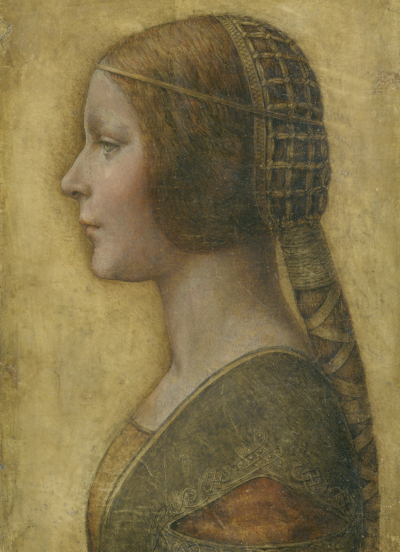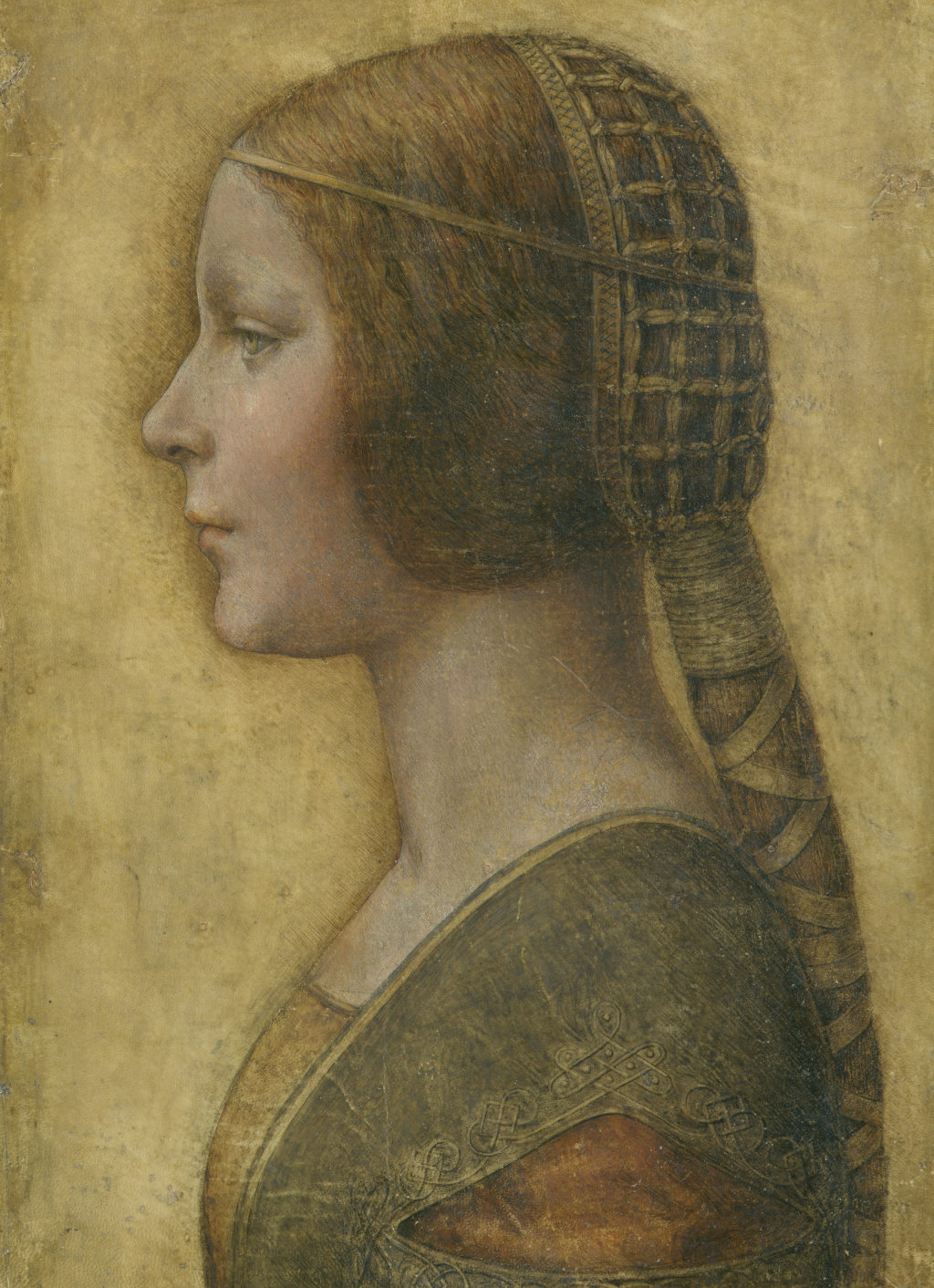La Bella Principessa is a Renaissance drawing from around the late 15th century. In recent years, a number of prominent historians have attributed the piece to Leonardo da Vinci and believe the model to be Bianca Sforza.
Introduction
This delightful piece is entirely typical of Renaissance Italy, with a side profile of a prominent figure in traditional clothing. The drawing was mounted on a wooden panel, giving it a greater status than most portrait drawings of this period, which would instead be passed around studios as a means to study.
Da Vinci's connection to this piece has risen considerably over the past few decades, with a number of respected art historians now confidently claiming this piece to be a geniune part of his oeuvre. This has been reflected in a number of exhibitions, though some others are still yet to be convinced.
This level of controversy and mystery is nothing new within the great master's career, and indeed many of his paintings have received similar debates over the centuries. Modern research techniques, often making use of x-ray technology, have helped us to fill in some of these blanks, but many still remain.
Da Vinci himself is regarded as one of the finest draughtsman in history, achieving a level of precision that was rare, even within the Renaissance. Many would copy his techniques within their own careers, and his drawing ability would also help his work in other disciplines, such as invention, architecture and science.
This respected artist was famed for the subtlety of his work, producing lifelike qualities that had not been seen before within the Renaissance. He achieved this within both drawing and painting, and his levels observation, combined with regular practice helped him to raise the bar within this important artistic era. He successfully mastered different drawing mediums such as metalpoint, pen and ink and chalk.
Da Vinci's success made him a highly desirable portrait artist, with many notable figures within Florence and Milan seeking to have their portraits, or those of a family member of close friend, produced by this respected artist. He would finally be able to pick and choose which commissions he took on, and moved around Italy in the pursuit of the biggest commissions possible.
Within this article we examine the many controversies around this drawing, such as its age, the identity of the model within it, and just who exactly completed the piece. We also examine the item's composition, explaining the qualities found within La Bella Principessa, and touch on technical details, such as the mediums used.
Table of Contents
- Introduction
- Description
- Who was Bianca Sforza?
- Age
- Attribution
- Size and Medium
- Large Image of La Bella Principessa
- References
Description
This stunning portrait, whose title translates as The Beautiful Princess in English, features a young woman in side profile. She looks off to our left, captured from the chest upwards. Her hair is an attractive auburn tone and she wears a pretty dress that is entirely in keeping with the fashions of Northern Italy during the late 15th century.
Her hair is smartly styled, with a pony tail which is encased within a traditional hair net, which is in a grid format across the back of her head, and then runs diagonally down the length of her pony tail. A small hair band then runs across her forehead to keep everything in place.
Her look is entirely in keeping with the style used in the Court of Milan, and many have claimed that Bianca Sforza was indeed the subject of this portrait. Experts have judged her age to be in the early teens but this would not quite match with the age of the drawing in the mid-1490s, if the subject is indeed Bianca Sforza (she would have been in her early twenties at this point).
The drawing is completed fully, with the background deliberately left blank, but all foreground detail finished to a high level. The artist used multiple tones of chalk alongside other heighteners in order to deliver this beautiful drawing and it must have been an important commission or project to go to such lengths - typically Leonardo, for example, would only concentrate his efforts on the facial features of a drawing, particularly when it was an early study for a later painting.
This side profile angle was typical of Renaissance portraits, but would also often be used as a means to depicting important figures. This makes the possibility of it being Bianca Sforza, the relation of Ludovico Sforza, who also happened to be employing Leonardo da Vinci at the time, more likely. This side format also mirrors coin designs, which would capture leading historical figures on their backs in most cases and was also another avenue of expression for artists during the Renaissance era.
Who was Bianca Sforza?
Bianca Sforza would be married off in her early teens to Galeazzo Sanseverino, who was the captain of the duke of Milan's forces. He was also a donor to Leonardo, who was well connected within the city more generally at this point. She would sadly die soon afterwards, and this portrait may have been produced to celebrate her marriage, as was a comon driver of portraiture at the time.
Leonardo would find employment with the Sforza family for a number of years whilst based in the Italian city of Milan. He received a number of opportunities thanks to these connections, but would also sometimes have to take on projects that he might otherwise have preferred not to.
Portraits of women were common at times of newborn children, or other events such as weddings and engagements. It may well have been the case that this drawing was completed because of Bianca Sforza's marriage, but sadly she passed away fairly soon after, possibly due to complications of pregnancy, which was entirely common across Europe at that time.
Age
La Bella Principessa is currently dated to around 1495-6, which places in the period of Leonardo's career in which he regularly worked with chalk for his drawn portraits. This date remains contested however, and over the centuries a wide variety of suggestions have been put forward.
In terms of the current date given, in the mid 1490s, much of this hangs off the model being Bianca Sforza, and that the drawing was completed by Leonardo or a member of his circle. These claims seem more likely than others put forward, and have also been backed by a number of high profile, respected art historians in recent years.
It must also be remembered that recent studies into the piece have also been considerably more detailed and exhaustive than previous ones, revealing many potential new findings about the piece, and so a good level of evidence backs up many of these new claims. La Bella Principessa: The Story of the New Masterpiece by Leonardo da Vinci by Martin Kemp delivered two years of research into this drawing, and lays the foundations for what many believe to be true today.
Attribution
The attribution of this piece has varied over the centuries, and as recently as 1998 the item was advertised as being from the German School, from the early 19th century. Over the past two decades the attribution has been switched to Da Vinci by a number of prominent art historians, potentially increasing its artistic importance considerably, but also bringing a further piece into the impressive oeuvre of this famous artist.
The debates still rage over the correct attribution of this piece, and further evidence has been put forward in a recent publication titled, La Bella Principessa di Leonardo da Vinci Ritratto di Bianca Sforza by Kemp and Cotte. All of the information provided here around its attribution was derived from Wikipedia via a number of respected resources, and we would recommend those articles for anyone looking to understand more about the current discussions being had.
Size and Medium
La Bella Principessa is sized at 33 cm in height, by 23.9 cm in width (13 in × 9.4 in). It was completed using black, red and white chalk with additional touches of pen and ink. Unusually for a Renaissance drawing, it was completed on an oak panel, with a piece of vellum laid over the top in order to receive the chalk medium.
Large Image of La Bella Principessa
We have included a larger image below of La Bella Principessa which has a higher resolution and allows you to see more of the detail added by the artist all those centuries ago. Whoever produced this piece, it is undeniably a stunning piece and one of the better Renaissance portrait drawings to still exist today. Typical of Leonardo and his followers, the facial features are beautifully delivered.
References
- Leonardo. The Complete Paintings and Drawings, Frank Zöllner & Johannes Nathan, Taschen
- Leonardo da Vinci, Walter Isaacson





